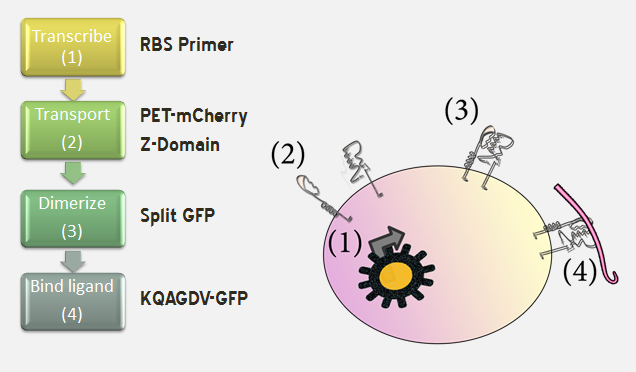Team:GeorgiaTech/Objective
Main Page

Objective
The objective for our project is ultimately to express human integrins on the surface of E.Coli cells. By expressing human integrins on bacteria cells, we can manipulate the cells to respond to specific stimuli in their environment. The specific integrin we are trying to express on the E.Coli cell has the ability to bind to fibrinogen. If it is successfully placed on the cell, the cell will be able to bind to fibrinogen, effectively coagulating or clotting blood. This has applications in the medical field, where the integrin-containing E.Coli (BioBots, as we like to call them) can be administered as a topical solution and prevent excessive bleeding on major surface wounds. A bacteria’s ability to express integrins has other applications as well. Since the bacteria will be able to send and receive signals to its environment, the bacteria can theoretically detect and locate cancer cells, as well as any other specific cell or structure of concern. These novel bacterial robots will represent the first prokaryotic use of heterodimeric integrins for a sensory function and will represent a platform that will enable future “design” of integrins sensory function through molecular evolution techniques.Background
Cells perform their intended functions not individually but collectively by forming temporally evolving, three dimensional structures comprised of clusters of cells, and through active or passive cell-cell and cell-extracellular matrix (ECM) interactions. Thus the development of engineered, integrative cellular systems that self-heal and adapt their microstructure to a variety of stimuli in the surrounding microenvironment will revolutionize the way bioengineers design. The goals of EBICS is to address the grand challenge of engineering multi-cellular biological machines that have desired functionalities and can perform prescribed tasks.These machines consist of sensing, information processing, actuation, protein expression, and transport elements that can be effectively combined to create functional units. Fortunately, nature provides plenty of inspiration through similarly functioning organisms and systems. It is therefore feasible to assume that artificial materials and organisms of the future will incorporate such naturally inspired designs. The imitation of the aforementioned functions will require development of systems similar to specialized cells in the various human tissues. The GT iGEM team will work toward the lofty goal of developing of cells and/or extracellular vesicles (e.g. platelets) that display designer sensory-response behaviors. In particular, small ‘smart’ biobots are an interesting avenue to duplicate the function of cells responsible for repair and adaptation. One of the tools that eukaryotic cells have at their disposal to detect their surroundings are heterodimeric sensor molecules present on the cell surface, known as integrins. Not only do integrins receive and facilitate cellular integration of extracellular cues, but they also support inside-out signaling and thus can dynamically impact their microenvironment. As a consequence of integrin’s critical role in this cell-ECM “dynamic reciprocity”, they represent the ideal sensor to build into a biobot. Synthetic biology applications are traditionally performed in the bacterial systems due to their availability, convenience, and speed. In order to complete our goal of expressing human integrins on the surface of bacterial cells, we will need a variety of lab and research materials necessary to experiment with the cells and eventually incorporate the integrins onto them. We will then need a way to test the effectiveness of the integrins on the cells. All funds given to us will help cover our lab material expenses.
Project Overview
In order to create BioBot v1, we needed to develop a toolbox to facilitate the expression of our sensors. We targeted four steps that are essential to achieving our first iteration of a BioBot and the successful integration of integrins in a bacteria model: successful transcription, transport, dimerization, and binding. Five parts were developed to achieve these four steps.
 "
"


